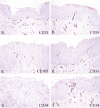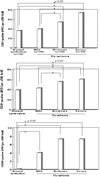Angiogenic squamous dysplasia-like phenomenon in oral epithelial precursor lesions
- PMID: 19661015
- PMCID: PMC3458642
- DOI: 10.1186/2047-783x-14-7-315
Angiogenic squamous dysplasia-like phenomenon in oral epithelial precursor lesions
Abstract
Statement of the problem: Dysplasia, the morphological yardstick of epithelial precursor lesions, is the collective term for a variety of architectural and cytological changes within the altered oral epithelium. Angiogenic squamous dysplasia (ASD), a distinct morphological characteristic in pre-invasive bronchial lesions, describes the presence of capillary tufts that are closely juxtaposed to and projecting into the dysplastic bronchial epithelium.
Objective: To determine whether ASD-like phenomenon occurs in oral epithelial precursor lesions, and to speculate on its relevance.
Methods: Twenty cases each of mild, moderate and severe oral dysplasia (inclusive of carcinoma-in-situ), and 10 normal oral mucosa (normal controls) were serial sectioned for H and E staining, and for microvessel density (MVD) scoring with CD31, CD34 and CD105. Microcapillary pattern images were digitally captured for 3-D reconstruction.
Results: Oral ASD foci consisting of CD31- and CD34-positive capillary loops abutting onto the overlying dysplastic oral epithelium (and causing it to assume an irregular or papillary surface configuration) were identified in moderate (3/20; 15%) and severe dysplasia (13/20; 65%), but not in normal oral mucosa and mild dysplasia. MVD score demonstrated increasing vascularity as epithelium progressed from normal to severe dysplasia (p<0.05). CD105 demonstrated increase neovascularization in all dysplasia grades (p<0.05).
Conclusions: These preliminary findings taken together suggest that: 1. ASD-like phenomenon may be an important intermediary biomarker in oral precursor lesions; and 2. architectural alterations of the entire disturbed mucosa may be a more useful pre-malignancy index.
Figures


Similar articles
-
Immunohistochemically Detection of Angiogenesis in Oral Pre-Cancerous Lesions Compared with Oral Invasive Carcinomas.Asian Pac J Cancer Prev. 2018 Jul 27;19(7):1805-1808. doi: 10.22034/APJCP.2018.19.7.1805. Asian Pac J Cancer Prev. 2018. PMID: 30049191 Free PMC article.
-
Immunohistochemical Expression of VEGF and Microvessel Density (CD 34) in Oral Epithelial Dysplasia and Oral Squamous Cell Carcinoma: Original Research.Asian Pac J Cancer Prev. 2025 Jan 1;26(1):147-151. doi: 10.31557/APJCP.2025.26.1.147. Asian Pac J Cancer Prev. 2025. PMID: 39873996 Free PMC article.
-
Mast cell density and angiogenesis in oral dysplastic epithelium and low- and high-grade oral squamous cell carcinoma.Acta Odontol Scand. 2010 Sep;68(5):300-4. doi: 10.3109/00016357.2010.494622. Acta Odontol Scand. 2010. PMID: 20586672
-
Angiogenesis in pre-malignant conditions.Eur J Cancer. 2009 Jul;45(11):1924-34. doi: 10.1016/j.ejca.2009.04.007. Epub 2009 May 4. Eur J Cancer. 2009. PMID: 19406633 Review.
-
Angiogenesis in benign, pre-malignant and malignant vulvar lesions.Anticancer Res. 2002 Nov-Dec;22(6C):3853-65. Anticancer Res. 2002. PMID: 12553005 Review.
Cited by
-
Immunohistochemically Detection of Angiogenesis in Oral Pre-Cancerous Lesions Compared with Oral Invasive Carcinomas.Asian Pac J Cancer Prev. 2018 Jul 27;19(7):1805-1808. doi: 10.22034/APJCP.2018.19.7.1805. Asian Pac J Cancer Prev. 2018. PMID: 30049191 Free PMC article.
-
Assessment of the association of OCT3/4 with GLUT1 and CD105 in oral squamous cell carcinoma using dual immunohistochemistry.BMC Oral Health. 2022 Jul 19;22(1):300. doi: 10.1186/s12903-022-02332-w. BMC Oral Health. 2022. PMID: 35854304 Free PMC article.
-
Strawberry gingivitis as the first presenting sign of Wegener's granulomatosis: report of a case.Eur J Med Res. 2011 Jul 25;16(7):331-4. doi: 10.1186/2047-783x-16-7-331. Eur J Med Res. 2011. PMID: 21813375 Free PMC article.
-
Expression of Endoglin (CD-105) and Microvessel Density in Oral Dysplasia and Squamous Cell Carcinoma.J Clin Diagn Res. 2014 Sep;8(9):ZC91-4. doi: 10.7860/JCDR/2014/9429.4904. Epub 2014 Sep 20. J Clin Diagn Res. 2014. PMID: 25386532 Free PMC article.
-
Comparison of orosomucoid-1 immunoexpression and angiogenesis between oral squamous cell carcinoma cases with different histological grades.J Oral Maxillofac Pathol. 2021 May-Aug;25(2):368. doi: 10.4103/0973-029X.325243. Epub 2021 Aug 31. J Oral Maxillofac Pathol. 2021. PMID: 34703136 Free PMC article.
References
-
- Folkman J, Shing Y. Angiogenesis. J Biol Chem. 1992;267(16):10931–10934. - PubMed
-
- Keith RL, Miller YE, Gemmill RM, Drabkin HA, Dempsey EC, Kennedy TC, Prindiville S, Franklin WA. Angiogenic squamous dysplasia in bronchi of individuals at high risk for lung cancer. Clin Cancer Res. 2000;6(5):1616–1625. - PubMed
-
- Hirsch FR, Franklin WA, Gazdar AF, Bunn PA Jr. Early detection of lung cancer: Clinical perspectives of recent advances in biology and radiology. Clin Cancer Res. 2001;7(1):5–22. - PubMed
-
- Shibuya K, Hoshino H, Chiyo M, Iyoda A, Yoshia S, Sekine Y, Iizasa T, Saitoh Y, Baba M, Hiroshima K, Ohwada H, Fujisawa T. High magnification bronchiovideoscopy combined with narrow band imaging could detect capillary loops of angiogenic squamous dysplasia in heavy smokers at high risk for lung cancer. Thorax. 2003;58(11):989–995. doi: 10.1136/thorax.58.11.989. - DOI - PMC - PubMed
Publication types
MeSH terms
Substances
LinkOut - more resources
Full Text Sources
Research Materials

